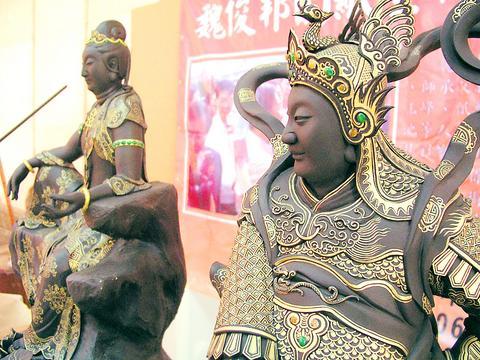Among the many colorful decorations on display at the 2004 Keelung Ghost Festival, a massive paper sculpture created by paper artist Wei Chun-pang (
Given the intricacy and splendor of the sculpture, most people would never guess that it was made of paper. In fact, according to Wei, the ancient Chinese divided religious sculptures into four descending categories: paper, terracotta, wood and porcelain. Depite being ranked first, paper sculptures are now a rarity.

PHOTO: YANG PEI-HWA, TAIPEI TIMES
According to Wei, the rarity of paper sculptures is because of the complex and highly labor intensive nature of the process, which is reflected in their high cost.
By the Qing Dynasty (1644 to 1911), paper sculptures were already becoming a rarity, Wei said. There are now very few practitioners of this art in Taiwan and in China, the art form has almost completely died out due to the suppression of religion.
Paper sculptures originated in the Tang Dynasty (AD 618 to AD 960) in China and the technology required to create paper sculptures has been handed down through the centuries.
Very simply, the sculpture is based on a rough model made from stiff paper board. This is then covered with up to 20 layers of tissue-thin cotton paper, applied three layers at a time. A varnish is then applied, after which the detail is carved.
There follows the process of outlining, inlaying gold, painting and finishing. Wei said that the process is extremely arduous, and it would be possible to create a five or six wood sculpture of the same size and intricacy in the same time it would take to make one of paper.
The important difference is that the paper sculpture is more resistant to pests such as termites and can last much longer than wood -- up to 600 years according to Wei. Because of the enormous cost, there is not much market demand for paper sculptures any more.
The nine-tailed dragon created for the 2004 Keelung Ghost Festival is a remarkable testament to the subtle expression that this art form is capable of.
Translated by Lin Ya-ti

President William Lai (賴清德) yesterday delivered an address marking the first anniversary of his presidency. In the speech, Lai affirmed Taiwan’s global role in technology, trade and security. He announced economic and national security initiatives, and emphasized democratic values and cross-party cooperation. The following is the full text of his speech: Yesterday, outside of Beida Elementary School in New Taipei City’s Sanxia District (三峽), there was a major traffic accident that, sadly, claimed several lives and resulted in multiple injuries. The Executive Yuan immediately formed a task force, and last night I personally visited the victims in hospital. Central government agencies and the

Australia’s ABC last week published a piece on the recall campaign. The article emphasized the divisions in Taiwanese society and blamed the recall for worsening them. It quotes a supporter of the Taiwan People’s Party (TPP) as saying “I’m 43 years old, born and raised here, and I’ve never seen the country this divided in my entire life.” Apparently, as an adult, she slept through the post-election violence in 2000 and 2004 by the Chinese Nationalist Party (KMT), the veiled coup threats by the military when Chen Shui-bian (陳水扁) became president, the 2006 Red Shirt protests against him ginned up by

As with most of northern Thailand’s Chinese Nationalist Party (KMT) settlements, the village of Arunothai was only given a Thai name once the Thai government began in the 1970s to assert control over the border region and initiate a decades-long process of political integration. The village’s original name, bestowed by its Yunnanese founders when they first settled the valley in the late 1960s, was a Chinese name, Dagudi (大谷地), which literally translates as “a place for threshing rice.” At that time, these village founders did not know how permanent their settlement would be. Most of Arunothai’s first generation were soldiers

Among Thailand’s Chinese Nationalist Party (KMT) villages, a certain rivalry exists between Arunothai, the largest of these villages, and Mae Salong, which is currently the most prosperous. Historically, the rivalry stems from a split in KMT military factions in the early 1960s, which divided command and opium territories after Chiang Kai-shek (蔣介石) cut off open support in 1961 due to international pressure (see part two, “The KMT opium lords of the Golden Triangle,” on May 20). But today this rivalry manifests as a different kind of split, with Arunothai leading a pro-China faction and Mae Salong staunchly aligned to Taiwan.